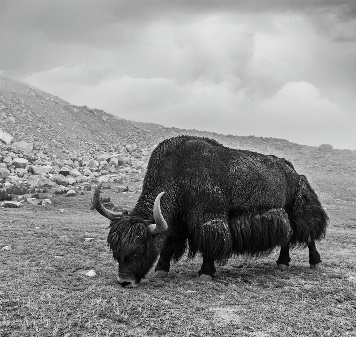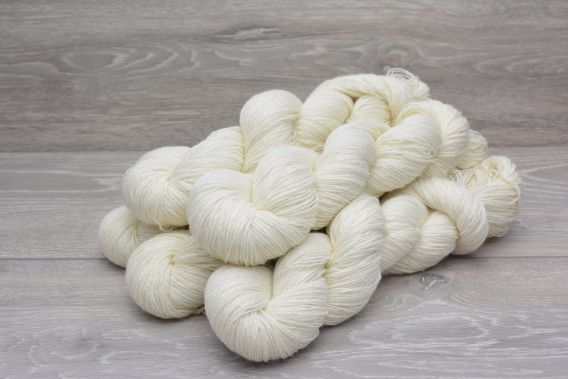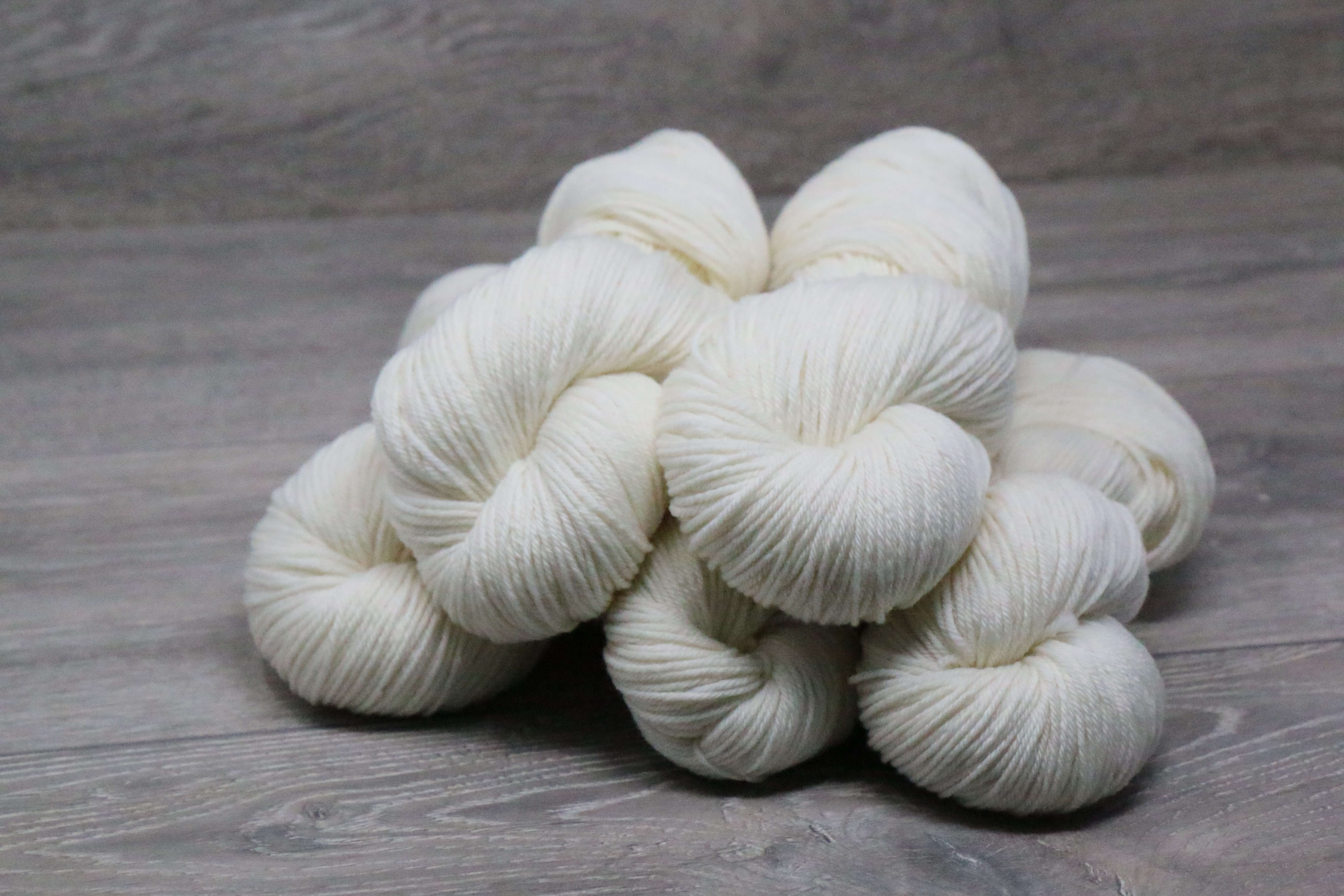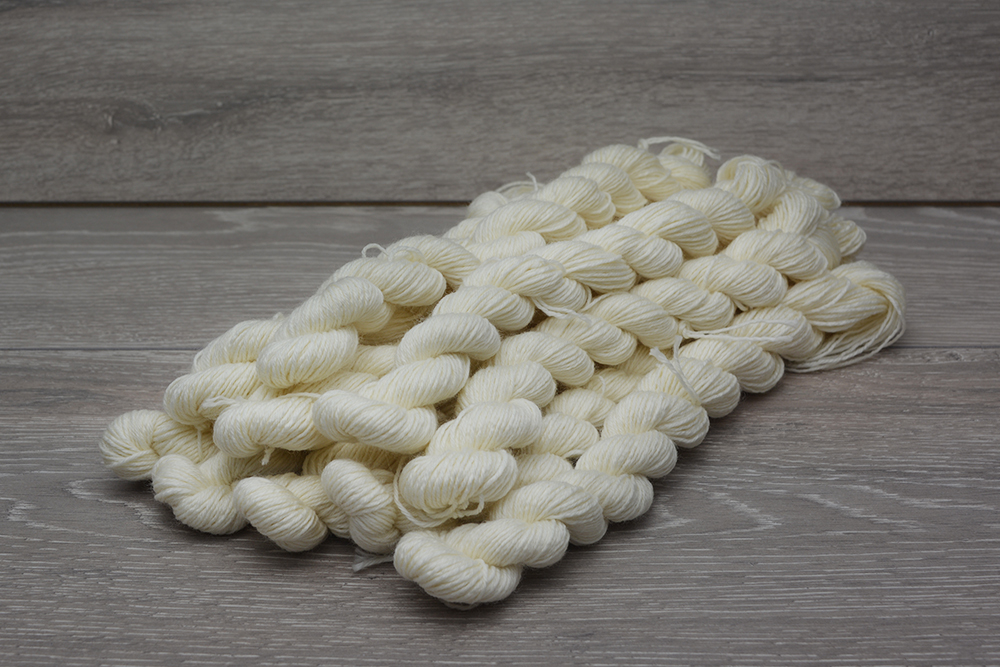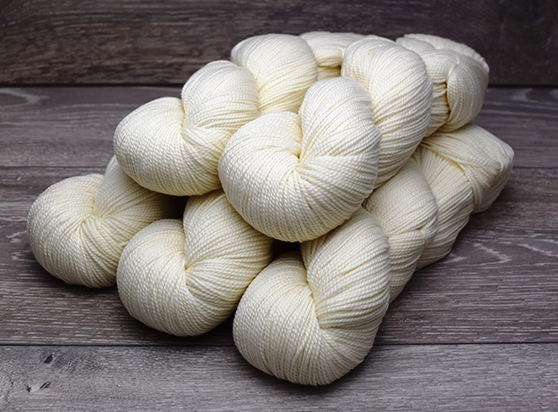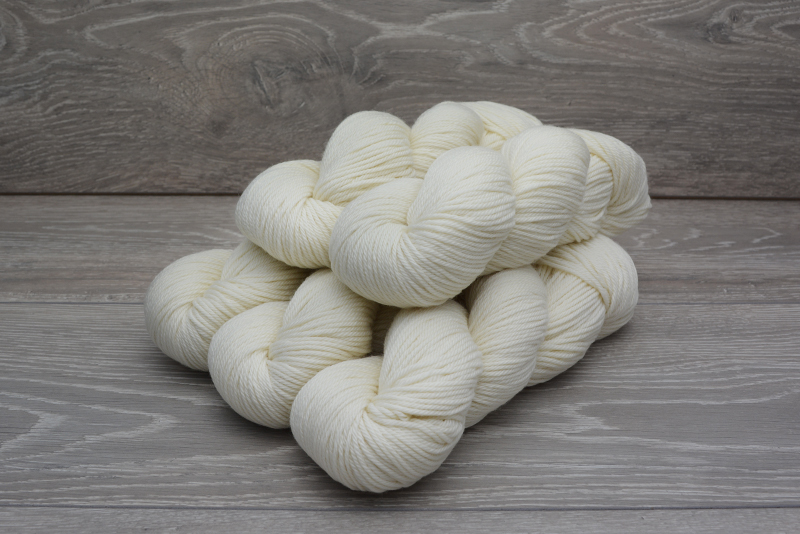
+ 44 (0)1274 911801+ 44 (0)1274 911801

A C Wood (Speciality Fibres) Limited 15 Bradford Business Park, Kings Gate, Bradford,
Preparing Yarn for Dyeing
Before dyeing the yarn check the ties on the hanks to ensure they are all secure. Ties can come undone, especially if they are used to pull the hank out of the dye pot which places a lot of pressure on them. We recommend adding a reusable zip tie or shower ring around the hank. This makes it much easier to pull the hank out of the dye pot and helps prevent tangles.
SHOULD I SCOUR YARN BEFORE DYEING?
Scouring is simply the textile word for washing. Proper scouring is essential to good dyeing. Improperly scoured items may not dye evenly and the dyed item may not be fast. Scouring removes any oils, dirt and natural coatings on the fibres.
All yarns have a little spinning oil added at the combing and spinning stages so that they go smoothly through the spinning and plying machines. Once spun, the yarn is reeled onto hanks and steamed to set the twist. This steaming process removes most of the spinning oil, but not all, so we always recommend scouring our yarns before dyeing to ensure all traces of spinning oil are removed.
Some fleeces such as BFL are naturally very greasy and you may notice more oil coming out of BFL yarns when you scour them. This is normal and is both the spinning oil and natural BFL oils being removed. Unbleached cellulose fibres also tend to colour the wash water more.
STEPS TO SCOUR YARN.
There are many different 'recipes' to scour yarn. This is the one we use which works well on all of our bases.
1. Fill a bucket or basin with enough luke warm water to cover the yarn.
2. Add a squirt of dish washing soap or cheap shampoo and mix thoroughly (for the scientifically minded use about 1-2 grams of detergent per 100 grams of yarn). The plainer the detergent the better, there is no need for any fancy ingredients or scents.
3. Add the yarn and gently push it down into the warm water but don't agitate it. The warmth of the water and the detergent remove the oils, not agitation.
4. Wait 60 minutes.
5. Remove the yarn, squeeze excess water out and rinse gently. The wash water can be reused for additional hanks of yarn until it looks noticeably dirty. Top up with hot water so it is warm before you add the next batch of hanks.
6. The yarn is now ready to dye.
If you are scouring non-superwash yarns (including alpaca, mohair and cashmere), treat the yarn gently and do not agitate. This avoids the risk of the yarn felting.
SHOULD I SCOUR YARN BEFORE DYEING?
Scouring is simply the textile word for washing. Proper scouring is essential to good dyeing. Improperly scoured items may not dye evenly and the dyed item may not be fast. Scouring removes any oils, dirt and natural coatings on the fibres.
All yarns have a little spinning oil added at the combing and spinning stages so that they go smoothly through the spinning and plying machines. Once spun, the yarn is reeled onto hanks and steamed to set the twist. This steaming process removes most of the spinning oil, but not all, so we always recommend scouring our yarns before dyeing to ensure all traces of spinning oil are removed.
Some fleeces such as BFL are naturally very greasy and you may notice more oil coming out of BFL yarns when you scour them. This is normal and is both the spinning oil and natural BFL oils being removed. Unbleached cellulose fibres also tend to colour the wash water more.
STEPS TO SCOUR YARN.
There are many different 'recipes' to scour yarn. This is the one we use which works well on all of our bases.
1. Fill a bucket or basin with enough luke warm water to cover the yarn.
2. Add a squirt of dish washing soap or cheap shampoo and mix thoroughly (for the scientifically minded use about 1-2 grams of detergent per 100 grams of yarn). The plainer the detergent the better, there is no need for any fancy ingredients or scents.
3. Add the yarn and gently push it down into the warm water but don't agitate it. The warmth of the water and the detergent remove the oils, not agitation.
4. Wait 60 minutes.
5. Remove the yarn, squeeze excess water out and rinse gently. The wash water can be reused for additional hanks of yarn until it looks noticeably dirty. Top up with hot water so it is warm before you add the next batch of hanks.
6. The yarn is now ready to dye.
If you are scouring non-superwash yarns (including alpaca, mohair and cashmere), treat the yarn gently and do not agitate. This avoids the risk of the yarn felting.
Source of Fibres
It is important for us to know where the fibres used in our yarns come from and to ensure they are produced and processed in ways that do not harm the animals or the environment. Our fibres are sourced from reliable material suppliers where we can establish best practise in relation to animal husbandry and the environment, as well as the best rearing and grading practices.
No animals are injured to provide our fibre as we only use shorn or material that has shed naturally from the animal.
The merino fibre we use is from sheep where mulesing is NOT practicised. We purchase the majority of our 19.5 micron merino from Australia and we pay a premium to purchase only Australian wool which is certified as mulesing free. The remainder of our merino is sourced from South America where mulesing is not necessary due to the climate. All of our wool is sourced from farms which comply with high animal welfare standards.
Our alpaca fibre is grown in Peru, mostly on small family-owned smallholdings. Our supplier has close ties with the producers and provides support to local communities as well as undertaking and sharing research to help the farmers get the most out of their flocks.
The BFL fibre we use is produced in the UK where high standards of animal welfare are in place. It is sourced from individual farms by the British Wool Marketing Board and graded to ensure it is of high quality. We only use the highest grade of BFL fibre.
Kid Mohair fibre is from South Africa. Our producer there is committed to making sure high animal welfare and environmental standards are met on its farms.
The majority of superwash yarn is treated using the Hercosett process, which is the method used for our superwash yarns too. Many people are rightly concerned over the potentiall impacts this process can have on the environment. The main concern being about how the waste water containing spent chemicals is dealt with after processing. We only use reputable companies to superwash our fibres, companies who hold ISO14001 accreditation and/or engage in best practice with regard to environmental performance and waste water treatment and re-use. Most of the effluent from the process is re-used and any disposed of has to meet strict environmental standards.
No animals are injured to provide our fibre as we only use shorn or material that has shed naturally from the animal.
The merino fibre we use is from sheep where mulesing is NOT practicised. We purchase the majority of our 19.5 micron merino from Australia and we pay a premium to purchase only Australian wool which is certified as mulesing free. The remainder of our merino is sourced from South America where mulesing is not necessary due to the climate. All of our wool is sourced from farms which comply with high animal welfare standards.
Our alpaca fibre is grown in Peru, mostly on small family-owned smallholdings. Our supplier has close ties with the producers and provides support to local communities as well as undertaking and sharing research to help the farmers get the most out of their flocks.
The BFL fibre we use is produced in the UK where high standards of animal welfare are in place. It is sourced from individual farms by the British Wool Marketing Board and graded to ensure it is of high quality. We only use the highest grade of BFL fibre.
Kid Mohair fibre is from South Africa. Our producer there is committed to making sure high animal welfare and environmental standards are met on its farms.
The majority of superwash yarn is treated using the Hercosett process, which is the method used for our superwash yarns too. Many people are rightly concerned over the potentiall impacts this process can have on the environment. The main concern being about how the waste water containing spent chemicals is dealt with after processing. We only use reputable companies to superwash our fibres, companies who hold ISO14001 accreditation and/or engage in best practice with regard to environmental performance and waste water treatment and re-use. Most of the effluent from the process is re-used and any disposed of has to meet strict environmental standards.
Worsted Spinning Long Staple Fibres
We use longer fleece in our yarn types which means that we are able to produce our yarns on worsted system. The fibres are washed, carded and then the combed (aligned) before spinning. Worsted spun yarns spun form longer staple fibres are more luxurious and refined, stronger and will feel softer and smoother.
The use of longer, combed fibre and the removal of the shorter fibres during the combing process, significantly reduce pilling in the resultant yarn.
The use of longer, combed fibre and the removal of the shorter fibres during the combing process, significantly reduce pilling in the resultant yarn.






